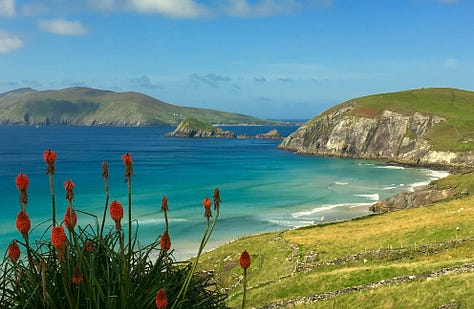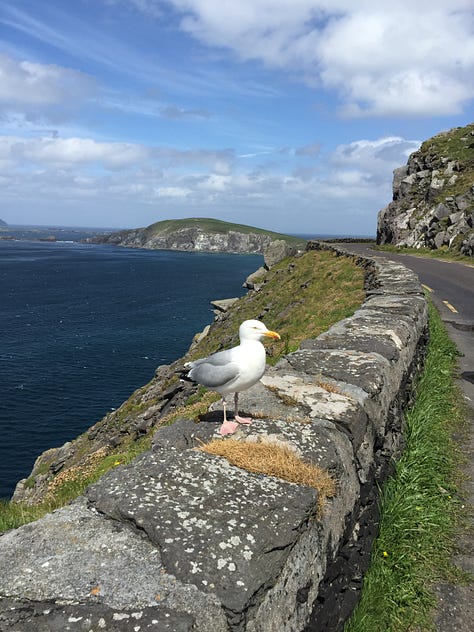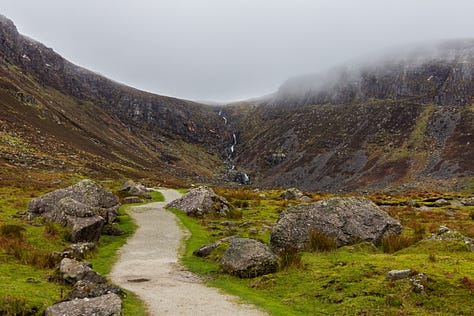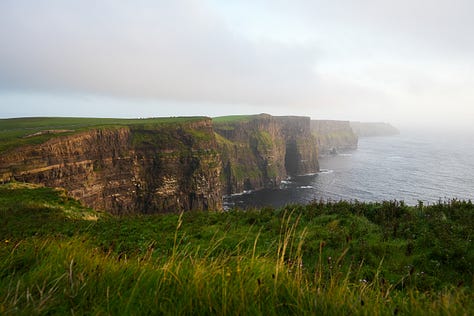✝️✝️✝️First, thank you to the nearly 200 people enjoying our Lent series, The Last Lament. It is not too late to join. Every weekday at 6:12 AM (Central), you will receive an article from me for that day as we journey through Psalm 22. People love it, and we welcome you, too. Become a Paid Subscriber, and you are all set.✝️✝️✝️
A Personal Moment with Patrick
A dozen years ago, I led a church tour to Ireland. Our group arrived eager to explore the land of St. Patrick, but I soon realized that our guide—though well-versed in Ireland and Irish history—knew little about its patron saint. That night, I decided to refresh my memory of Patrick’s life and legacy.
In a single sitting, I read through his Confessio, his account of his life in his own words. It was riveting. He didn’t seem like a 1700-year-old cartoon saint; he seemed like a friend whose life had been thoroughly shaped and enchanted with the power of the Gospel.
The next morning, as we wound our way along the breathtaking cliffs of the Dingle Peninsula, I opened The Confession—Patrick’s own words—and began reading aloud.



The road twisted along the edge of the world, where green cliffs fell into icy blue waters, waves crashed against black rocks, and white beaches lay untouched beneath the sunny sky. By the time we reached the farthest west one could go, with nothing but the Atlantic stretching before us, we were all in tears.
Patrick’s words were alive—full of humility, passion, and deep conviction. It felt as though he was speaking directly to us across the centuries, reminding us that Christ is near, that grace is real, and that our lives, too, are meant for mission.
A Life Shaped by Hardship
Patrick’s Confession is more than an autobiography, though. It is a testimony of redemption and calling. He was born around 380 AD in Scotland—probably. As a teenager, he was kidnapped by Irish raiders and taken to Northern Ireland as a slave. That brutal hardship forced him to confront his own sins and his need for a Savior.
He later wrote:
“I am a sinner, a simple country person, and the least of all believers. I am looked down upon by many.”
The loneliness of captivity brought Patrick face to face with his failures. Something in his past weighed heavily on him—though we don’t know what it was, the memory of his mistakes haunted him in his slavery. Yet, in that wilderness, he understood God's grace.
Echoing the words of Psalm 139, he wrote:
“God watched over me before I knew him, and before I came to wisdom and could distinguish between good and evil… He protected me and consoled me as a father does for his son.”
Patrick escaped from slavery, but his story didn’t end there. Instead of returning to a quiet life, he returned to the land of his captivity—not for vengeance, but for mission.
This is the power of the Gospel. It saves, and then it sends.
To the Ends of the Earth—Literally
Patrick was one of the few people in history who took Jesus’ Great Commission as a direct and personal command.
When Jesus said, “Go therefore and make disciples of all nations… to the ends of the earth.” (Matthew 28:19-20), he went!
At that time, Ireland was considered the edge of the known world—a land so remote that even the Romans had never fully conquered it. The Dingle Peninsula, where I first read his words aloud, juts into the Atlantic, beyond which there was only open sea. Many thought of it as the last inhabitable place before the world’s edge.



Yet Patrick journeyed all the way to the westernmost settlements, determined to bring Christ even to those living at the margins of civilization. He himself wrote:
“I have traveled everywhere among you for your own sake, in many dangers, even to the furthest parts where nobody lived beyond.” (Confession, 51)
Patrick believed the Gospel must go as far as human feet could walk, as far as a ship could sail, and as far as people could be found. His mission in Ireland was the literal fulfillment of Christ’s words: “And you will be my witnesses… to the ends of the earth.” (Acts 1:8)
This is the part that impressed me most: I knew people who took the Great Commission seriously—to go to the ends of the earth. However, I had never met anyone who took it geographically—to the literal ends of the earth.
Patrick went there!
Patrick and Paul: Twins Born 300 Years Apart
What impressed me also about Patrick was his nearly complete connection with the Apostle Paul. The Confessions reveal an unmistakable connection—he saw himself as a sinner redeemed by grace, a missionary to the Gentiles, and a man whose life was spent suffering for the Gospel.
Patrick and Paul were twins, brothers in Christ, separated by only a few centuries. Otherwise, they both seemed to believe their lives were saved and sent by the power and person of Jesus Christ.
Like Paul, Patrick saw himself as unworthy of his calling:
“I am a sinner, a simple country person, and the least of all believers.” (Confession, 1)
Yet, like Paul, he believed that God’s grace had appointed him for the task:
“I cannot be silent—nor would it be good to do so—about such great blessings and such a gift that the Lord so kindly bestowed in the land of my captivity.” (Confession, 3)
Both men endured beatings, imprisonment, betrayals, and hardships, yet both counted it as joy to suffer for Christ. Paul wrote:
“I have worked much harder, been in prison more frequently, been flogged more severely, and been exposed to death again and again.” (2 Corinthians 11:23)
Patrick could have said the same. He was enslaved, attacked, opposed by fellow clergy, and nearly killed for his faith. But he was undaunted, just as Paul was, because he saw his suffering as participation in the mission of Christ.
“I have cast myself into the hands of almighty God, who is the ruler of all places, as the prophet says: ‘Cast your concerns on God, and he will sustain you.’” (Confession, 55)
Paul and Patrick were driven by one unshakable conviction—that the Gospel must go forth, no matter the cost. And in Patrick’s case, it would go as far as the earth itself extended.
Today’s Culture, Our Mission, and God’s Love
We should take a lesson from Patrick today. His story proves that no society is beyond the reach of the Gospel. Ireland was a land of pagan warlords and slave traders, utterly opposed to Christian teaching. Yet Patrick, transformed by Christ’s love, refused to see its people as enemies. Instead, he loved them.
Patrick would have agreed with many Christian thought-leaders today who warn against the temptation to withdraw from a wicked world in contempt and judgment. He would remind us: ‘You cannot hate the people you are trying to reach.’
He did not return to Ireland to condemn it, but to redeem it. Remember, he had been trafficked by warlords and sold as a slave. After he met the Lord, he returned to the scene of their crime to save them.
The Roman Empire was crumbling at the time, and Ireland was considered a lost cause. Patrick saw it as a mission field.
The First Anglican?.
When Augustine of Canterbury arrived in England in 597 AD, he believed he was bringing Christianity to the British Isles for the first time. This supposedly began the Anglican Church, the Roman Catholic church on the British Isles.
But he quickly discovered something remarkable—Christianity had already taken root. The faith had arrived from the north! Through the mission of Patrick and his followers centuries before.
This reminds me of the quip I heard many years ago about the Anglicans being late to the missionary enterprise:
Baptists enter the mission field on foot, Methodists on horseback, and Anglicans wait for the trains with Pullman cars.
While there is some truth in the humor—Anglicans were often slower to mobilize for missions—Patrick was an exception. He didn’t wait for the train; he walked, sailed, and struggled into the heart of Ireland, determined to bring Christ to its people.
Let’s Get Personal
Patrick’s faith was not just theological; it was deeply personal. His most famous prayer, The Lorica—or The Breastplate of St. Patrick—reveals what it means to walk closely with Christ.
Take a moment to slow down. Read this prayer aloud—not as a history lesson, but as your prayer. Let it remind you that a personal relationship with Christ is more than a concept; it is the steady companionship of a faithful friend.
The Lorica - Patrick of Ireland
Christ with me, Christ before me, Christ behind me, Christ in me, Christ beneath me, Christ above me, Christ on my right, Christ on my left, Christ when I lie down, Christ when I sit down, Christ in the heart of every man who thinks of me, Christ in the mouth of every man who speaks of me, Christ in the eye that sees me, Christ in the ear that hears me.
These simple words are as powerful today as they were in Patrick’s time.
This weekend, as we mark the holiday, many use it as an excuse for riotous parties and green beer; whether you mark the occasion with a gathering, a prayer, or even a glass raised in celebration, honor Patrick not just with a toast, but by following his example. Let’s give thanks for Christ’s power to save and send us into the world.
David Roseberry ☩
The Anglican
A Collect for St. Patrick
Almighty God, who in your providence chose your servant Patrick to be the apostle of the Irish people, to bring those who were wandering in darkness and error to the true light and knowledge of you: Grant us so to walk in that light, that we may come at last to the light of everlasting life; through Jesus Christ our Lord, who lives and reigns with you and the Holy Spirit, one God, now and ever. Amen
The Anglican is the Substack newsletter for LeaderWorks, where I share insights, encouragement, and practical tools for clergy and lay Christians. I’m also an author of over a dozen books available on Amazon.
If you are a Paid Subscriber, thank you! Thank you for supporting The Anglican and the ministry of LeaderWorks. If you are not a subscriber, please consider becoming one today.







